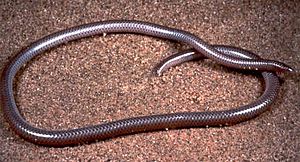Rena humilis facts for kids
Quick facts for kids Rena humilis |
|
|---|---|
 |
|
| Conservation status | |
| Scientific classification | |
| Genus: |
Rena
|
| Species: |
humilis
|
| Synonyms | |
|
|
The Rena humilis, often called the western blind snake, western slender blind snake, or western threadsnake, is a type of snake. It belongs to the family called Leptotyphlopidae. These snakes are special because they are endemic (meaning they are only found) in the southwestern United States and northern Mexico. There are six different kinds, or subspecies, of this snake that scientists know about.
Contents
What Does the Western Blind Snake Look Like?
The western blind snake, like many snakes in its family, looks a lot like a long earthworm. It lives underground in burrows, which are tunnels it digs. Because it lives in the dark, it doesn't need good eyesight. Its eyes are mostly vestigial, meaning they are tiny and not very useful for seeing. They are just small black spots that can sense light.
This snake can be pink, purple, or silvery-brown. It has a shiny, worm-like body that is round and blunt at both ends. Its head is very strong and thick. This helps it dig through the soil easily. It also has a small spine at the end of its tail. It uses this spine to push against things and help it move forward when burrowing.
The western blind snake is usually less than 30 cm (12 in) long, which is about the length of a ruler. It is also as thin as an earthworm. A cool fact about these snakes is that they can glow under special ultraviolet light, like a black light!
Where Does the Western Blind Snake Live?
The western blind snake is found in the southwestern United States and northern Mexico. In the US, you can find it from southwestern Texas all the way west through southern Arizona, southern Nevada, southwestern Utah, and southern California.
In Mexico, it lives in many states. These include Baja California, Sonora, Sinaloa, Nayarit, Jalisco, Colima, Chihuahua, Durango, Coahuila, Tamaulipas, and San Luis Potosí.
What Does the Western Blind Snake Eat?
These snakes spend most of their lives underground. They can dig very deep, sometimes as far as 20 metres (66 ft) down! They are known to go into ant and termite nests. This is because their main diet is made up of insects. They especially like to eat insect larvae (baby insects) and eggs.
You can find them in deserts and scrub areas. They prefer places where the soil is loose and easy for them to dig through.
Images for kids
Rena humilis at the TIGR Reptile Database. Accessed 08 December 2013.



